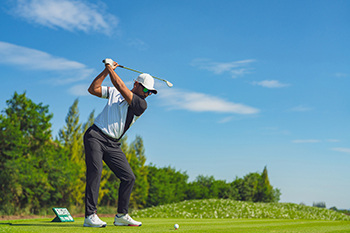
Golf is a great sport and can provide a wonderful outlet for recreation and socialization. You may not think that you can injure yourself playing golf, but you would be wrong. Golf injuries are often the result of not warming up properly, using improper swing mechanics, overdoing it, and having an incorrect grip and setup. Golf injuries may occur in the back, hips, elbows, knees, shoulder, wrist, hands, feet, and ankles. The feet are particularly important to provide the body with the balance it needs to stay steady when hitting the ball on all kinds of surfaces, while also providing the necessary power to complete the swinging process. Injuries may occur if you lose your footing, try to hit on an uneven surface, or practice poor swinging form. Ankle sprains, tendinitis, and inflammation can also plague the golfer, as can blisters from wearing improper shoes. To learn more about keeping your feet and ankles healthy while playing golf, or for treatment of any painful condition, contact your local chiropodist.
Injuries to the foot and ankle are very common among athletes. If you have experienced an injury, please consult with Chiropodist Stephanie Poupore from North Bay Foot & Ankle. Our clinician will assess your condition and provide you with quality foot and ankle treatment.
Common Injuries Among Athletes:
-
Achilles tendon injuries
-
Ankle strains or sprains
-
Plantar fasciitis
-
Fractures
-
Turf toe
-
Joint dislocations
-
Sever’s disease
-
Morton’s neuroma
Symptoms
Symptoms will depend on the cause and severity of the injury. Common symptoms for a foot or ankle injury include pain, swelling, tenderness, bruising, a reduced range of motion, and difficulty bearing weight or walking on the affected foot or ankle.
Diagnosis
Sports injuries are typically diagnosed after carefully examining the affected foot or ankle. This includes moving the injured area to test its range of motion. Medical history will need to be provided, as well as detailed information about how the injury occurred. Imaging studies, such as X-rays or MRIs, may be used to confirm or rule out certain diagnoses.
Treatment
Just like symptoms, treatment will depend on the type of injury and its severity. Initial treatment for many sports injuries is aimed at controlling inflammation and promoting the healing response. The acronym R.I.C.E is a helpful guide to implement for most acute injuries. This method involves resting, icing, compressing, and elevating the affected foot or ankle. In addition, anti-inflammatory medications may be administered and orthotic devices may be prescribed. For more severe injuries, surgery may be required. Lastly, rehabilitation or physical therapy may be needed to gain full functionality in the afflicted area.
If you have any questions, please feel free to contact our office located in . We offer the newest diagnostic and treatment technologies for all your foot care needs.
